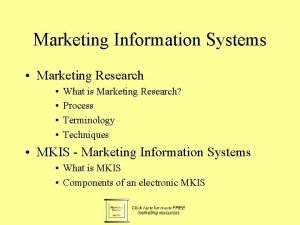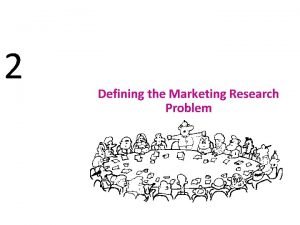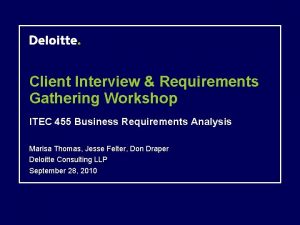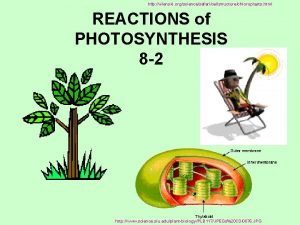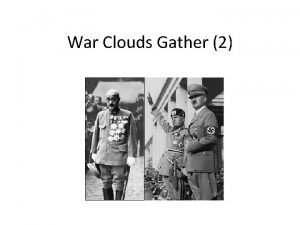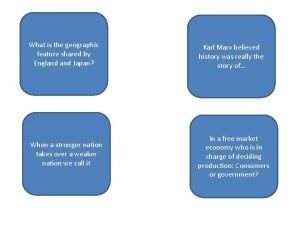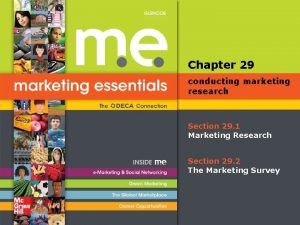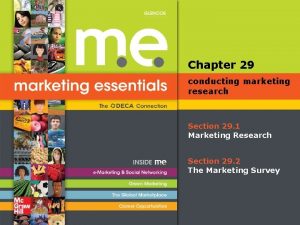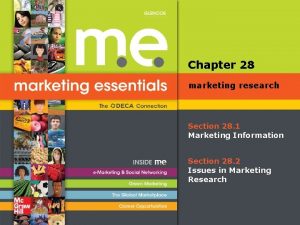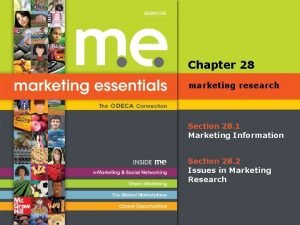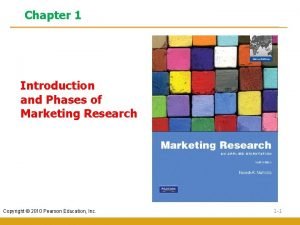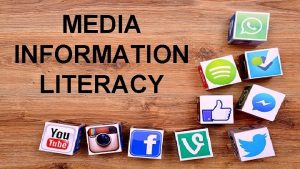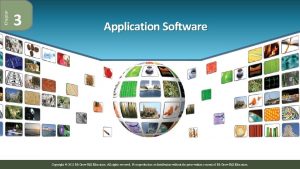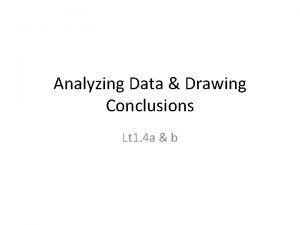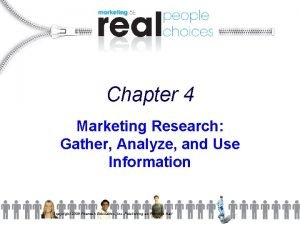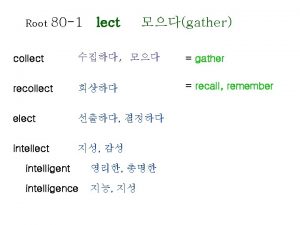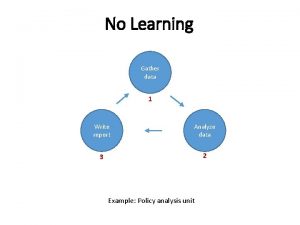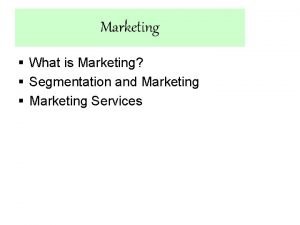Chapter 4 Marketing Research Gather Analyze and Use





































- Slides: 37

Chapter 4 Marketing Research: Gather, Analyze, and Use Information


The project - Develop a campaign promoting tourism in Mauritius § The Research Objective: Identify ‘why do people love Mauritius’ § The Research Method: – “The Laziest Person in the World” contest – Sentence completion contest in print ads • “I love Mauritius because _______” • Answer: “___ I can surf, swim, sunbathe, hike, camp out in the rain forest, eat great food, relax, energize, hit the casino and a million other things in a place smaller than the palm of my hand” – Insight: Mauritius: bursting at seams with things to do in spite of being so small a place § Ad baseline: Mauritius: 99% fun, 1% land

Knowledge Is Power § Accurate, up-to-date, relevant information is the fuel that runs the marketing engine § Understanding consumers’ value needs is essential to creating/delivering a value proposition 4 -4 Copyright 2009 Pearson Education, Inc. Publishing as Prentice Hall

Knowledge Is Power § Marketing information systems: Determine what information marketing managers need, then gathers, sorts, analyzes, stores, and distributes information to system users § Marketing information systems include multiple components 4 -5 Copyright 2009 Pearson Education, Inc. Publishing as Prentice Hall

Figure 4. 2 The Marketing Information System 4 -6 Copyright 2009 Pearson Education, Inc. Publishing as Prentice Hall

Internal Company Data § Internal data: Information from within the company to produce reports on the results of sales and marketing activities § Intranet: Internal corporate communications network that links company departments, employees, and databases 4 -7 Copyright 2009 Pearson Education, Inc. Publishing as Prentice Hall

Marketing Intelligence § Marketing intelligence systems: Method by which marketers get information about everyday happenings in the marketing Get the scoop environment on mystery – Example: Monitoring the Internet shopping! and using “mystery shoppers” § Futurists specialize in predicting consumer trends 4 -8 Copyright 2009 Pearson Education, Inc. Publishing as Prentice Hall

It’s Debatable Class Discussion Question Faith Popcorn, the 1990’s “Nostradamus of Marketing” according to Fortune magazine, is a well-known pop culture futurist. Visit her Web site and view one or more of the Trend Bank videos. Put yourself in the position of the consumer goods marketer of your choice. How will this trend impact the marketing of your brand? Will it have a positive impact or a negative impact? Why? Visit Faith Popcorn’s Brain. Reserve 4 -9 Copyright 2009 Pearson Education, Inc. Publishing as Prentice Hall

Marketing Research § Market research: Collecting, analyzing, and interpreting data about customers, competitors, and the business environment to improve marketing effectiveness – Syndicated research – Custom research 4 -10 Copyright 2009 Pearson Education, Inc. Publishing as Prentice Hall

Acquired Databases § External databases can be used to collect a variety of information from different sources The census – Non-competing businesses – Government databases offers great free information § Misuse of databases can be problematic and has led to do-not-call lists and antispam laws 4 -11 Copyright 2009 Pearson Education, Inc. Publishing as Prentice Hall

Marketing Decision Support Systems § Marketing decision support systems: Data plus analysis and interactive software that allows managers to conduct analyses and find the information that they need 4 -12 Copyright 2009 Pearson Education, Inc. Publishing as Prentice Hall

Figure 4. 3 The Marketing Decision Support System 4 -13 Copyright 2009 Pearson Education, Inc. Publishing as Prentice Hall

Searching for Gold: Data Mining § Data mining: Includes sophisticated analysis techniques to take advantage of the massive amount of transaction information now available § Analysts sift through data to identify unique patterns of behavior among different customer groups for use in behavioral targeting 4 -14 Copyright 2009 Pearson Education, Inc. Publishing as Prentice Hall

It’s Debatable Class Discussion Question The popularity of social network sites such as My. Space, Facebook, Second Life, and others has been growing tremendously. Under pressure to increase revenues, Facebook now allows marketers to create brand pages, which after being viewed by a user, feeds directly to that person’s “friends. ” Does this move to viral marketing violate the privacy of Facebook’s users? Will it hurt membership? Advertising on Facebook 4 -15 Copyright 2009 Pearson Education, Inc. Publishing as Prentice Hall

What Marketers Can Do with Data Mining § Data mining applications in marketing: – Customer acquisition – Customer retention and loyalty – Customer abandonment – Market basket analysis 4 -16 Copyright 2009 Pearson Education, Inc. Publishing as Prentice Hall

Steps in the Marketing Research Process § Step 1: Define the research problem – Specifying research objectives – Identifying consumer population of interest – Placing the problem in an environmental context Burke Research Video 4 -17 Copyright 2009 Pearson Education, Inc. Publishing as Prentice Hall

Steps in the Marketing Research Process § Step 2: Determine the research design – Determine whether secondary data are available – Determine whether primary data are required and if so, what type: • Exploratory research • Descriptive research • Causal research 4 -18 Copyright 2009 Pearson Education, Inc. Publishing as Prentice Hall

Figure 4. 5 Marketing Research Designs 4 -19 Copyright 2009 Pearson Education, Inc. Publishing as Prentice Hall

Secondary and Primary Research § Secondary data: – Have been collected for some purposes other than the problem at hand Guideline. com (industry and trend reports) Dialog. com (sorts firms by location, size, industry) Lexisnexis. com (information database) 4 -20 Copyright 2009 Pearson Education, Inc. Publishing as Prentice Hall

Secondary and Primary Research § Primary data: – Information collected directly from respondents to specifically address the question at hand Look-Look employs an army of “coolhunters” to report on the latest trends 4 -21 Copyright 2009 Pearson Education, Inc. Publishing as Prentice Hall

Exploratory (Qualitative) Research § Exploratory research techniques generate insights for future, more rigorous studies – Typically involve in-depth consumer probing – Take many forms: • • • 4 -22 Consumer interviews Focus groups Productive techniques Case studies Ethnography Copyright 2009 Pearson Education, Inc. Publishing as Prentice Hall

Descriptive (Quantitative) Research § Descriptive research studies: – Probe systematically into the problem – Base conclusions on large numbers of observations – Typically expresses results in quantitative terms (averages, percentages, other stats) • Cross-sectional design • Longitudinal design 4 -23 Copyright 2009 Pearson Education, Inc. Publishing as Prentice Hall

Causal Research § Cause-and-effect relationships: A change in one thing causes a change in something else – Independent (cause) vs. dependent (change in outcome) variables – Experiments test predicted relationships among variables in a controlled environment 4 -24 Copyright 2009 Pearson Education, Inc. Publishing as Prentice Hall

Steps in the Marketing Research Process § Step 3: Choose the method for collecting primary data – Survey methods are used to interview respondents – Questionnaires: • loosely, moderately, or completely structured – Observational research methods – Online research 4 -25 Copyright 2009 Pearson Education, Inc. Publishing as Prentice Hall

Questionnaires § Mail questionnaires § Telephone interviews § Face-to-face interviews – Mall intercept § Online questionnaires 4 -26 Copyright 2009 Pearson Education, Inc. Publishing as Prentice Hall ?

Observational Methods § Observation: Data collection method where the researcher records consumers’ behaviors, often without their knowledge – Personal observation – Mechanical observation – Unobtrusive measures 4 -27 Copyright 2009 Pearson Education, Inc. Publishing as Prentice Hall

Observation Methods Wireless users at the Connection Court are easily observed 4 -28 Unobtrusive measures such as Garbology look for physical evidence that remains after some action has been taken Copyright 2009 Pearson Education, Inc. Publishing as Prentice Hall

Online Research § Types of online research: – Gathering information via consumer surfing – Gathering information via Web site/ email/chat room questionnaires/focus groups § Online research used as part of: – New-product development – Estimating market response – Exploratory research § IM and focus groups 4 -29 Copyright 2009 Pearson Education, Inc. Publishing as Prentice Hall

Data Quality: Garbage In, Garbage Out § How much faith should marketing managers place in research? Three key considerations include: – Validity – Reliability – Representativeness 4 -30 Copyright 2009 Pearson Education, Inc. Publishing as Prentice Hall

Figure 4. 6 Completion Test Obtaining accurate information from children can be very difficult. To encourage kids to express their feelings, researchers used this completion test. Boys were asked to write in the balloon what they think the boy in the drawing will say when the girl asks, “What program do you want to watch next? ” 4 -31 Copyright 2009 Pearson Education, Inc. Publishing as Prentice Hall

Step 4: Design the Sample § Probability sampling: – Each member of the population has some known chance of being included – Sample is representative of population, and inferences about population are justified § Types of probability sampling: – Simple random sampling – Systematic sampling – Stratified sampling 4 -32 Copyright 2009 Pearson Education, Inc. Publishing as Prentice Hall

Step 4: Design the Sample § Nonprobability sample – Personal judgment used in selecting respondents – Some members of population have no chance of being included so sample is not representative of population § Types of nonprobability sampling – Convenience sampling – Quota sampling 4 -33 Copyright 2009 Pearson Education, Inc. Publishing as Prentice Hall

Step 5: Collect the Data § Challenges to gathering data in foreign countries include: – Differences in sophistication of research operations – Infrastructure/transportation challenges – Lack of phones and/or low literacy rates – Local customs and cultural differences – Language translation difficulties 4 -34 Copyright 2009 Pearson Education, Inc. Publishing as Prentice Hall

Step 6: Analyze and Interpret the Data § Data must be analyzed and interpreted to be meaningful § Tabulation: – Arranging data in a table or other summary form to get a broad picture of overall responses § Cross-tabulation: – Examining the data by subgroups to see how results vary between categories 4 -35 Copyright 2009 Pearson Education, Inc. Publishing as Prentice Hall

Step 7: Prepare the Research Report § Research reports typically contain the following sections: – Executive summary – Description of research methodology – Discussion of results including tabulations, cross-tabulations – Limitations of study – Conclusions and recommendations 4 -36 Copyright 2009 Pearson Education, Inc. Publishing as Prentice Hall

Ethics in Marketing Research § Marketing research ethics: Taking an ethical and above-board approach to conducting marketing research that does no harm to the participant in the process of conducting the research – Researchers must provide full disclosure of confidentiality and anonymity options 4 -37 Copyright 2009 Pearson Education, Inc. Publishing as Prentice Hall
 Finer segmentation
Finer segmentation Marketing information systems and marketing research
Marketing information systems and marketing research Marketing information system and marketing research
Marketing information system and marketing research Marketing information systems and marketing research
Marketing information systems and marketing research Marketing information systems and marketing research
Marketing information systems and marketing research Marketing information systems and marketing research
Marketing information systems and marketing research What is problem definition in marketing research
What is problem definition in marketing research How do journalists gather information
How do journalists gather information Sometimes the shadows gather lyrics
Sometimes the shadows gather lyrics Cubing can help you gather details about a topic by
Cubing can help you gather details about a topic by Counselling gather approach
Counselling gather approach How to gather client requirements
How to gather client requirements Gather acronym in counselling
Gather acronym in counselling Gather ye roses while ye may
Gather ye roses while ye may Gather the people enter the feast
Gather the people enter the feast Scatter gather dma
Scatter gather dma Plants gather energy with light-absorbing pigments called *
Plants gather energy with light-absorbing pigments called * The cloud gather 2
The cloud gather 2 People gather to worship
People gather to worship Morning offering prayer
Morning offering prayer Morning offering prayer
Morning offering prayer Langkah langkah konseling kb
Langkah langkah konseling kb Gather information definition
Gather information definition Why did indians gather in amritsar in 1919?
Why did indians gather in amritsar in 1919? Gather thee rosebuds while ye may
Gather thee rosebuds while ye may Chapter 29 conducting marketing research
Chapter 29 conducting marketing research Chapter 29 conducting marketing research answers
Chapter 29 conducting marketing research answers Chapter 28 marketing research
Chapter 28 marketing research Chapter 28 marketing research
Chapter 28 marketing research Introduction to marketing research chapter 1
Introduction to marketing research chapter 1 The marketing research process follows five steps
The marketing research process follows five steps Chapter 28 marketing research
Chapter 28 marketing research Yesterday
Yesterday Mil venn diagram
Mil venn diagram Study each picture carefully
Study each picture carefully What is media information
What is media information Programs that organize analyze and graph numerical data
Programs that organize analyze and graph numerical data Making conclusions from analyzed data
Making conclusions from analyzed data

